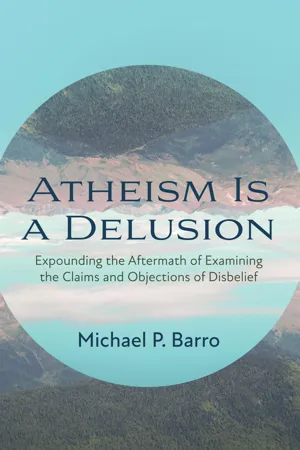
Atheism Is a Delusion
Expounding the Aftermath of Examining the Claims and Objections of Disbelief
- 124 pages
- English
- ePUB (mobile friendly)
- Available on iOS & Android
Atheism Is a Delusion
Expounding the Aftermath of Examining the Claims and Objections of Disbelief
About this book
Deep down, everyone, with very few exceptions, badly wants and needs clarity and assurance, especially when it comes to the deepest most profound existential questions of life--where did we come from (origin)? Why are we here (purpose)? What are we meant to do (morality)? And where are we going (destiny)? Much more, do heaven and hell exist? Is death the end of everything, or is there life in the hereafter? Thousands of Christians, at some point in their lives, admit being in doubt of their faith, especially when confronted with pressing questions on the Bible, God, Jesus, evil, death, suffering, science, evolution, etc. This book was painstakingly written to hopefully help provide philosophical and theological clarity and for them to be academically informed and be better assured of their Christian faith.As for the religious skeptics, and downright anti-theists, they similarly at some point may have been confronted with the same nagging question from the believers--What if you're wrong? This book is also written to enjoin them to assess the bases of their objections and justifications of their disbelief, inspire them to reconsider their positions, and keep an open-minded attitude to the gospel of Christ.
Frequently asked questions
- Essential is ideal for learners and professionals who enjoy exploring a wide range of subjects. Access the Essential Library with 800,000+ trusted titles and best-sellers across business, personal growth, and the humanities. Includes unlimited reading time and Standard Read Aloud voice.
- Complete: Perfect for advanced learners and researchers needing full, unrestricted access. Unlock 1.4M+ books across hundreds of subjects, including academic and specialized titles. The Complete Plan also includes advanced features like Premium Read Aloud and Research Assistant.
Please note we cannot support devices running on iOS 13 and Android 7 or earlier. Learn more about using the app.
Information
Table of contents
- Title Page
- Preface
- Chapter 1. Philosophical Technicalities
- Chapter 2. The Problem of Evil
- Chapter 3. Common Atheist Responses to Natural Revelation
- Chapter 4. Common Atheist Responses to Special Revelation
- Chapter 5. Fruits of Atheism
- Chapter 6. Atheism in the French Revolution
- Summary and Conclusion
- Bibliography